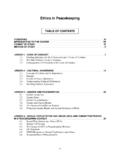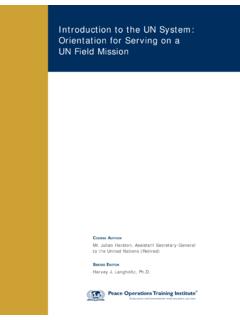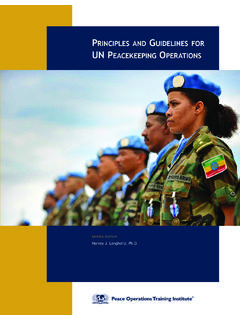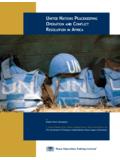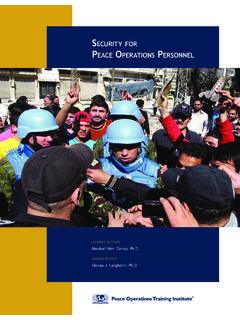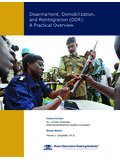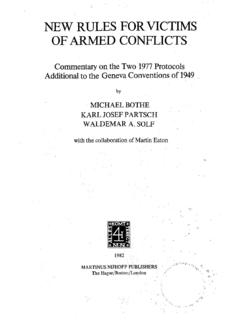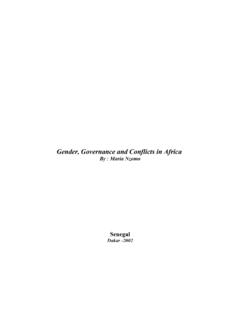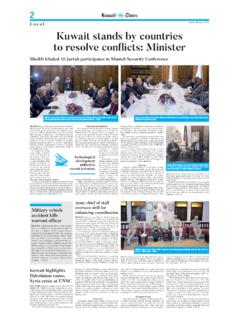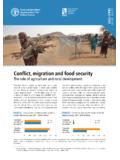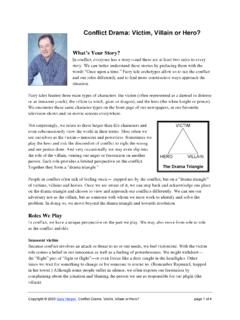Transcription of Protection of Civilians - Peace Operations Training …
1 Peace Operations Training Institute Study Peace and humanitarian relief any place, any timeCourse AuthorMr. Julian Harston Assistant Secretary-General, United Nations (retired)series editorHarvey J. Langholtz, of CiviliansPeace Operations Training Institute Study Peace and humanitarian relief any place, any timeCourse AuthorMr. Julian Harston Assistant Secretary-General, United Nations (retired)series editorHarvey J. Langholtz, of CiviliansCover Photo: UN Photo #575263 by the United Nations Mission in the Republic of South Sudan (UNMISS). Officers of the Japanese contingent of the UNMISS provide water to Civilians that have sought refuge at an UNMISS compound on the southwestern outskirts of Juba, fleeing fighting that broke out in the capital city. 17 December 2013. 2016 Peace Operations Training Institute. All rights Operations Training Institute 1309 Jamestown Road, Suite 202 Williamsburg, VA 23185 USA edition: October 2012 by Colonel Robert Manton (retired) Second edition: July 2016 by Mr.
2 Julian HarstonThe material contained herein does not necessarily reflect the views of the Peace Operations Training Institute (POTI), the Course Author(s), or any United Nations organs or affiliated organizations. The Peace Operations Training Institute is an international not-for-profit NGO registered as a 501(c)(3) with the Internal Revenue Service of the United States of America. The Peace Operations Training Institute is a separate legal entity from the United Nations. Although every effort has been made to verify the contents of this course, the Peace Operations Training Institute and the Course Author(s) disclaim any and all responsibility for facts and opinions contained in the text, which have been assimilated largely from open media and other independent sources. This course was written to be a pedagogical and teaching document, consistent with existing UN policy and doctrine, but this course does not establish or promulgate doctrine. Only officially vetted and approved UN documents may establish or promulgate UN policy or doctrine.
3 Information with diametrically opposing views is sometimes provided on given topics, in order to stimulate scholarly interest, and is in keeping with the norms of pure and free academic pursuit. Versions of this course offered in other languages may differ slightly from the primary English master copy. Translators make every effort to retain the integrity of the Operations Training INSTITUTeTable of ContentsProtection of CiviliansForeword ixMethod of Study xLesson 1 Protection of Civilians in United Nations Peacekeeping 12 Section What is Protection of Civilians in UN Peacekeeping? 14 Section Types of Physical violence Against Civilians 16 Section Who Provides Protection to Civilians ? 18 Section Background and History of POC in Peacekeeping 21 Section The POC Mandate and the Authorization to Use Force 23 Section POC Policy, Basic Guidelines, and Principles 27 Annex A: Ten Rules Code of Personal Conduct for Blue Helmets 30 Lesson 2 Legal Dimensions of Protection of Civilians 34 Section Legal Framework and International Legal Instruments 36 Section Normative Framework 41 Section Authorities, Obligations.
4 And Prohibitions 52 Section Accountability of the Peacekeeping Mission and the Individual Peacekeeper 54 Protection OF CIvILIANSPeACe Operations Training INSTITUTevILesson 3 Operational Concept on Protection of Civilians 60 Section Actualizing the Mandate into POC Operational Concept 62 Section Operational Concept for Protection of Civilians 63 Section The POC Response Phases and Corresponding Peacekeeping Activities 67 Lesson 4 Implementing the POC Mandate 74 Section Protection of Civilians Strategy 76 Section Protection Strategic Threat Assessments 77 Section Roles and Responsibilities of Mission Components 77 Section engagement and Coordination Mechanisms 78 Section Preparedness Activities 79 Section Key Challenges and Best Practices in the Field 80 Lesson 5 Other POC Issues 92 Section Prevention and Response to Sexual violence in Armed conflicts 94 Section Children and Armed Conflict 103 Section Protection of Humanitarian Workers 112 Section Protection of Journalists 113 Lesson 6 Lessons Learned and Non-Peacekeeping Protection of Civilians 116 Section The UN Charter, Security Council, and the Collective System of International Security 120 Section Convention on Genocide and Responsibility to Act 120 Section World Summit 2005 and Responsibility to Protect 121 Section Humanitarian interventions and Right to Intervene 124 Section Distinction Between Protection in UN Peacekeeping and Protection OF CIvILIANSPeACe Operations Training INSTITUTevIINon-Peacekeeping Protection 125 Lesson 7 Conclusions 128 Section Protection of Civilians as a Priority in UN Peacekeeping 130 Section expectation Management Regarding Protection of Civilians 133 Section Implications of Failure to Protect Civilians in UN Peacekeeping 134 Protection OF CIvILIANSPeACe Operations Training INSTITUTevIIIA ppendicesAppendix A.
5 List of Acronyms 138 Appendix B: Current Peacekeeping Missions 141 Appendix C: example Security Council Resolution 142 About the Author: Mr. Julian Harston 148 Instructions for the end-of-Course examination 149 Protection OF CIvILIANSPeACe Operations Training INSTITUTeIxWherever we serve in the world of peacekeeping, peacebuilding, and humanitarian work, all of us share a fundamental responsibility to do more to protect Civilians caught up in the horrors of war. In conflicts throughout the world, women, girls, boys, and men are subjected to blatant and frequent violations of international human rights and humanitarian law. The violations include killing, torture, kidnapping, rape, and mutilation. We see forced recruitment, including of children, and the denial of access to medical care and life-saving assistance. We also see displacement, which is so often the catalyst for lasting dependency, destitution, and lost Africa alone, at least 600,000 Civilians in 27 African countries have been massacred in the past two decades.
6 Tens of millions more have been killed in battles, displaced, or perished from indirect causes of such attacks and the continent s armed conflicts . Civilians are the main victims of many conflicts . An increasing number of United Nations Security Council resolutions have called upon peacekeepers to protect Civilians specifically. For many, civilian Protection is the essence of peacekeeping. This is a driving rationale behind the unanimously endorsed and UN-mandated Responsibility to Protect principle the idea that governments have a responsibility to prevent and stop genocide, crimes against humanity, war crimes, and ethnic cleansing. civilian Protection is also a crucial part of creating durable political settlements, as any Peace agreement that tolerates continued violence against Civilians will not provide a solid foundation on which to build a legitimate and sustainable future. Let us remember that Civilians do not suffer these horrors because they are in the wrong place at the wrong time and become what is still euphemistically referred to as collateral damage.
7 Civilians suffer more and more frequently because they are deliberately targeted. The Protection of Civilians is a critical issue. No one serving in the United Nations in the field as a soldier, police officer, or civilian can do so effectively without having an understanding of the Protection of Civilians . But protecting Civilians raises huge challenges. I hope that, through this course, you will learn to understand these challenges and your role in meeting them. Mr. Julian Harston, 2016 ForewordView a video introduction to this course at < >. Protection OF CIvILIANSPeACe Operations Training INSTITUTexMethod of StudyThis self-paced course aims to give students flexibility in their approach to learning. The following steps are meant to provide motivation and guidance about some possible strategies and minimum expectations for completing this course successfully: Before you begin studying, first browse through the entire course.
8 Notice the lesson and section titles to get an overall idea of what will be involved as you proceed. The material is meant to be relevant and practical. Instead of memorizing individual details, strive to understand concepts and overall perspectives in regard to the United Nations system. Set personal guidelines and benchmarks regarding how you want to schedule your time. Study the lesson content and the learning objectives. At the beginning of each lesson, orient yourself to the main points. If possible, read the material twice to ensure maximum understanding and retention, and let time elapse between readings. At the end of each lesson, take the End-of-Lesson Quiz. Clarify any missed questions by rereading the appropriate sections, and focus on retaining the correct information. After you complete all of the lessons, prepare for the end-of-Course examination by taking time to review the main points of each lesson. Then, when ready, log into your online student classroom and take the end-of-Course examination in one sitting.
9 Access your online classroom at < > from virtually anywhere in the world. Your exam will be scored electronically. If you achieve a passing grade of 75 per cent or higher on the exam, you will be awarded a Certificate of Completion. If you score below 75 per cent, you will be given one opportunity to take a second version of the end-of-Course examination. A note about language: This course uses english spelling according to the standards of the Oxford english Dictionary (United Kingdom) and the United Nations editorial Features of Your Online Classroom Access to all of your courses; A secure testing environment in which to complete your Training ; Access to additional Training resources, including multimedia course supplements; The ability to download your Certificate of Completion for any completed course; and Forums where you can discuss relevant topics with the POTI OF CIvILIANSPeACe Operations Training INSTITUTexI12In this lesson Lesson Objectives Peace Operations Training INSTITUTEPROTECTION OF CIVILIANSLESSONL esson TOCF ramework for a Global Organization, Past and PresentSection What is Protection of Civilians in UN Peacekeeping?
10 Section Types of Physical violence Against CiviliansSection Who Provides Protection to Civilians ?Section Background and History of POC in PeacekeepingSection The POC Mandate and the Authorization to Use ForceSection POC Policy, Basic Guidelines, and Principles Understand and describe the three basic approaches to POC. Identify types of violence against Civilians , the most vulnerable groups, and various perpetrators. Identify main Protection actors and explain their roles. Understand the background and history of POC in UN peacekeeping. Cite the basic documents, policies, and guidelines on POC. Understand the meaning of basic principles, definitions, and terminology on POC. Our peacekeepers must first and foremost protect Civilians from violence. Ban Ki-moon, Remarks to the Chiefs of Defence Conference, March 2015UN Photo #14788 by Eskinder of Civilians in United Nations Peacekeeping1 LeSSON 1 | Protection OF Civilians IN UNITeD NATIONS PeACeKeePING13 The Protection of Civilians (POC) is one of the most important and visible areas of United Nations peacekeeping activity, and the UN has recognized that peacekeepers regularly sacrifice their safety, and sometimes their lives, in this noble link between the Protection of Civilians and peacekeeping mandates is vital.


